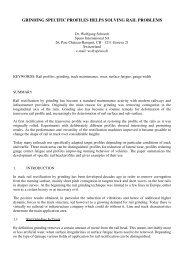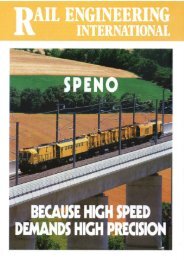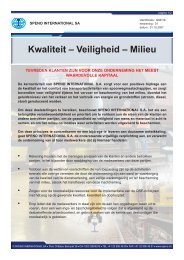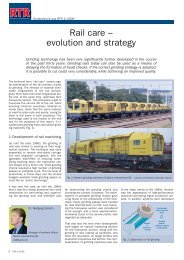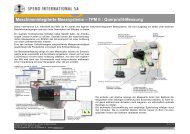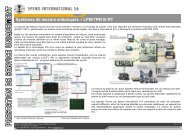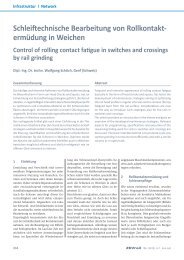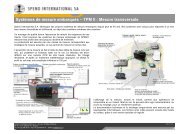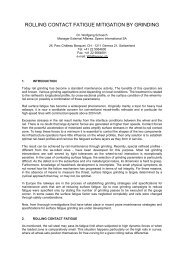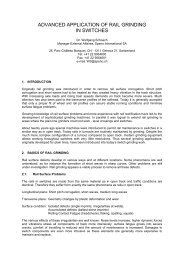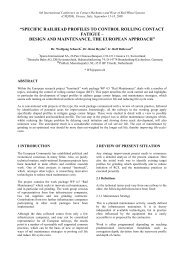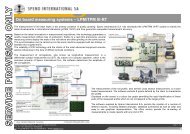joint research and testing of innovative grinding applications - speno ...
joint research and testing of innovative grinding applications - speno ...
joint research and testing of innovative grinding applications - speno ...
Create successful ePaper yourself
Turn your PDF publications into a flip-book with our unique Google optimized e-Paper software.
Wolfgang Schoech<br />
Speno International SA<br />
New Rail Maintenance Trends In Europe<br />
Anti-Headcheck-Pr<strong>of</strong>iles <strong>and</strong> Preventive Cyclical Grinding<br />
system. The system measures the variation <strong>of</strong><br />
an electric field caused by the cracks. Thus,<br />
damage depth, which is the top layer <strong>of</strong> the rail<br />
head surface that needs to be removed,<br />
depends on crack inclination <strong>and</strong> orientation.<br />
[6]<br />
Quite a number <strong>of</strong> modifications on the<br />
recording trolley were required to assure<br />
correct, high precision guiding <strong>of</strong> the probes<br />
closely over the surface, independent <strong>of</strong> the<br />
shape <strong>and</strong> wear situation <strong>of</strong> the rail. Equally<br />
laborious was the development <strong>of</strong> an<br />
appropriate s<strong>of</strong>tware package allowing for<br />
online interpretation <strong>of</strong> the data.<br />
Respective activities are under way in<br />
Australia.<br />
6. DEVELOPMENT OF GRINDING<br />
STANDARDS –<br />
The “INNOTRACK” project<br />
In Europe an international <strong>research</strong> project<br />
funded by the European Commission on<br />
<strong>innovative</strong> maintenance practices for railway<br />
infrastructure (“Innotrack”) has been<br />
terminated recently. Its results are at present<br />
disseminated to help infrastructure managers<br />
in their task <strong>of</strong> economical maintenance <strong>of</strong><br />
heavy duty tracks.<br />
This project also can be seen as a <strong>joint</strong><br />
<strong>research</strong> work between infrastructure<br />
managers <strong>and</strong> contractors. First <strong>of</strong> all regular<br />
meetings <strong>of</strong> the working groups assured an<br />
intense exchange <strong>of</strong> knowledge <strong>and</strong><br />
experience. Some specific test projects have<br />
been undertaken in laboratories by universities<br />
<strong>and</strong> <strong>research</strong> institutions. Other work packages<br />
concentrated on applied <strong>research</strong>.<br />
Figure 9: Eddy-current-system on a rail grinder<br />
Figure 10: Example head check recording<br />
Based on the experiences made a series <strong>of</strong><br />
systems is now in use with selected <strong>grinding</strong><br />
machines. Their continuous use under routine<br />
operational conditions has helped to further<br />
develop <strong>and</strong> fine-tune the system as well as to<br />
explore the limits. Of course, that development<br />
will never have a definite end.<br />
So far quite satisfactory results have been<br />
made. Due to the European railway conditions,<br />
i.e. mixed traffic on conventional lines using<br />
st<strong>and</strong>ard steel grades (R260) it will be<br />
interesting to see the performance <strong>of</strong> this socalled<br />
“HC-Grinding-Scanner” under different<br />
conditions, such as heavy haul operations.<br />
Results <strong>of</strong> such individual tests have been<br />
published <strong>and</strong> discussed earlier on. Due to the<br />
big number <strong>of</strong> project partners (well over thirty)<br />
<strong>and</strong> their previous works <strong>and</strong> experiences, the<br />
project setup allowed to complement, confirm<br />
<strong>and</strong> finetune the various conclusions. As the<br />
project moved on, a big number <strong>of</strong><br />
deliverables, i.e. technical documents has<br />
been published.<br />
Within subproject SP5 the working group WP<br />
4.5 - originally named “Validation <strong>of</strong> new<br />
maintenance processes”, later referred to as<br />
“Rail Maintenance”, looked into the rail sector.<br />
Besides rail lubrication <strong>and</strong> friction<br />
modification, rail repr<strong>of</strong>iling - taking into<br />
account optimal steel grade selection - was the<br />
main topic addressed.<br />
This working group was ordered to produce<br />
four documents:<br />
“Review <strong>of</strong> Present Maintenance Situation”<br />
“Target Pr<strong>of</strong>iles for Grinding”<br />
“Grinding strategies”<br />
“Lubrication <strong>and</strong> Friction Management”<br />
Finally a summary document entitled<br />
“Guidelines for management <strong>of</strong> rail <strong>grinding</strong>”,<br />
containing the most important results has been<br />
produced <strong>and</strong> published. [7]<br />
AusRAIL PLUS 2011<br />
22 – 24 November 2011, Brisbane




